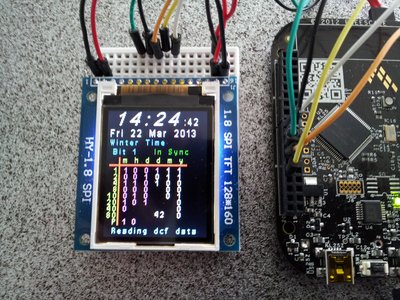Important changes to repositories hosted on mbed.com
Mbed hosted mercurial repositories are deprecated and are due to be permanently deleted in July 2026.
To keep a copy of this software download the repository Zip archive or clone locally using Mercurial.
It is also possible to export all your personal repositories from the account settings page.
Dependencies: HY-1_8TFT_ST7735 TSI mbed
Fork of KL25Z_DCF77_HY-1_8LCD by
Homepage
This project shows the KL25Z connected to a very cheap (3 Euros) Chinese TFT LCD Display (HY-1.8 SPI from Ebay). I have modified a ST7753 driver library to work the 8 bit SPI write that the Mbed library sets the FRDM board to (not sure why as the KL25Z MCU has16 bit cababiliy). The libraries are available for import from my home page. and includes five different fonts (three are needed for this example).
I have also used the Analog Out (pin PTE30) to control the LED back light level, simply connect a small NPN transistor in the LED -ve connection to ground and feed the analog out pin to the base of the transistor via a 10k ohm resistor. When you slide your finger across the TSI touch slider the display brightness can be changed from off to full level.
The code it much the same as the other projects I have published, just with different LCD drive code. This program will decode the DCF77 signal connected to pin PTE20 and set the RTC clock. The photo shows the display before I modified the LED backlight drive circuit.
The display runs at 5V and draws arround 20mA, the backlight led will also run at this voltage and is nice and bright. It can also be connected to the USB 3v pin and runs at a lower level. there is a solder jumper to bypass the 5v regulator, leave this open and it will run on both volages, if this jumper is closed it will bypass the regulator and if connected to the 5v supply, the display will be 'bricked' so take care!.
This display is considerably better and cheaper than the Nokia display but not as good as Oled. Easy to connect, 5 data connections and 2 power wires. It also includes a SD card slot that can be connected to the FRDM board.
The backlight is LED it does not use a switch mode DC-DC converter circuit so RF noise is very low, this is essential when using a sensitive VLF DCF77 radio receiver close by.
The FRDM board and display runs at 50mA depending on LED brightness.

